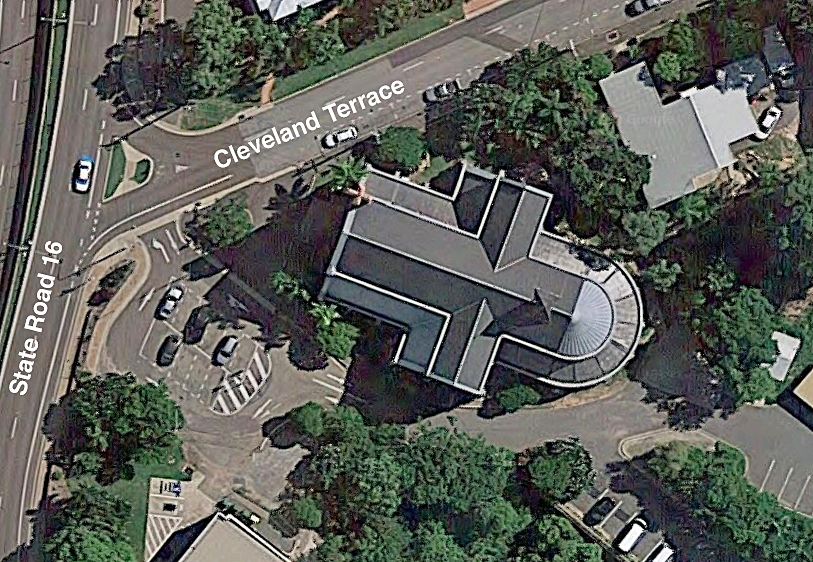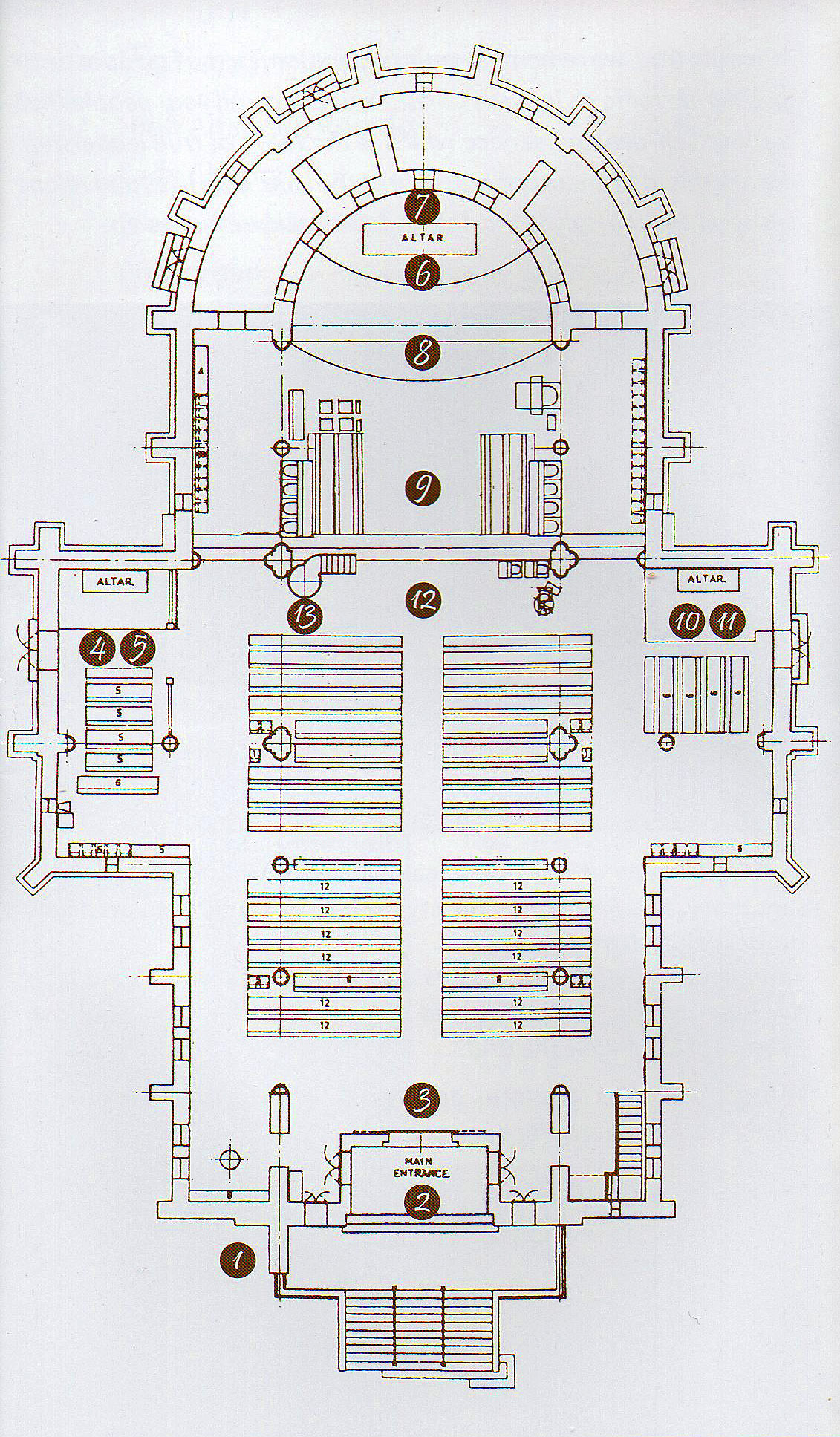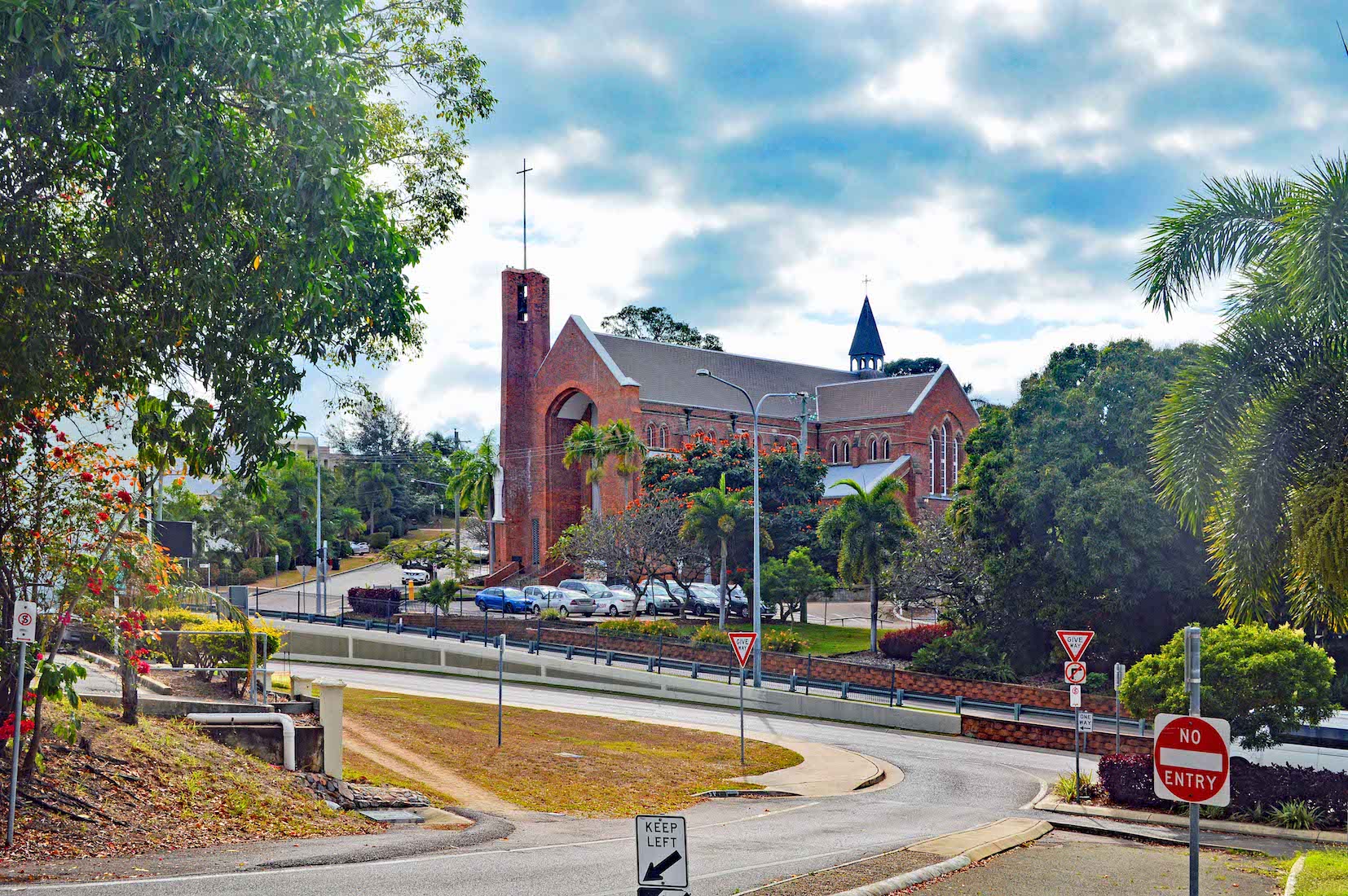ST JAMES’ CATHEDRAL
TOWNSVILLE, QUEENSLAND ANGLICAN
PAUL SCOTT

SATELLITE VIEW
From this view we see that St James’ Cathedral is essentially cruciform in shape, but with a large semicircular apse towards the east. In fact, the main axis of the Cathedral is just 20° off a geographical east–west direction – close enough for us to identify our geographical and liturgical directions without risk of confusion. The nave has covered aisles which extend to the West side of the transept. There is a small tower and spire to the East of the transept, and a bell tower with surmounting cross in the Northwest corner.
The Cathedral sits on the corner of State Road 16, and Cleveland Terrace which rises up on the North side. We shall begin our tour of St James’ near the West end and walk around the Cathedral in a clockwise direction. Returning to our starting point we shall enter through the West door.

This plan of the Cathedral comes from a Cathedral pamphlet, and the various numbers are referenced in that pamphlet. We shall make our own way, beginning at the West door (bottom), exploring the nave, transepts and ambulatories in order, and finally the choir and chancel.
You can access intermediate points in the tour by a tap / click on the following links:
To continue, tap / click on START!
Or, if you wish to go inside the Cathedral immediately, tap / click on Entry.
NOTE ON MAGNIFYING IMAGES
With this website format the images are large enough for most purposes. If there is a need for greater magnification of an image, go to the identical photo on
https://www.flickr.com/photos/paulscottinfo/albums
and use Command - + (Mac) or Windows - + (Windows).
HISTORY
[Wikipedia]
St James’ Cathedral is a heritage-listed cathedral of the Anglican Diocese of North Queensland at 36 Cleveland Terrace, Townsville, Australia. It was designed by Arthur Blacket and was built in 1887 by MacMahon & Cliffe. It was added to the Queensland Heritage Register on 21 October 1992.
Built atop Melton Hill the large red-brick structure is a well-known landmark of the Townsville central business district.
History
St James’ Cathedral was erected in two stages, 1887–1892 and 1959–1960, for the Anglican Diocese of North Queensland. Prior to the construction of a church, Anglican services in Townsville were conducted at the court house. The first Anglican church was established on Melton Hill, purchased with the aid of parishioners at a sale of crown lands and work began on the 24 May 1871. The structure was constructed of weatherboard with a shingle roof.
When Townsville was established in the mid-1860s, its Anglican parishioners were part of the Diocese of Sydney. In 1878 the diocese of North Queensland was created, based at St James’ Church in Townsville. The new diocese’s first bishop George Henry Stanton was appointed on 24 June 1878. Stanton did not immediately go to Townsville but spent several months in England, trying to raise funds and attract clergy for the new diocese. He finally arrived in Townsville in May 1879, preaching his first service on 21 May 1879. Having become the cathedral of the new diocese, St James’ Church was enlarged, extending the nave and north and south aisles in 1880 and an organ, donated by a Miss SE Holland (an English friend of Bishop Stanton), was added to the church in 1884.
Plans for a new and larger cathedral began on 5 August 1883 when members of the church formed a committee to raise the funds. The proposal to build a cathedral was approved by a church synod in 1884 and the Cathedral Building Committee was appointed. The intention initially was to have the cathedral designed by John Horbury Hunt. However, in 1885, Arthur Blacket of Sydney, son of Edmund Blacket (he New South Wales colonial architect) was commissioned to design a building to be erected on the church land behind the existing weatherboard structure. The initial designs called for a cathedral constructed of sandstone with granite columns which would hold 1000 parishioners. The nave would be 37 feet (11 m) wide, transepts would be 24 feet (7.3 m) wide and the total interior length from chancel to bell tower would be 115 feet (35 m). Many features of these designs were rejected upon review by the diocese and three revisions were necessary before a final plan was approved. The final design was for a church built in stone, with a low wide central tower which would act as a ventilation shaft, and a single tower at the northern door. It was to cost £24,000, but would be built in sections.
Early in 1887 the diocese called for tenders for the construction of the cathedral. The foundation stone was laid on the Golden Jubilee of Queen Victoria on 27 June 1887, and the building was erected by Townsville contractors MacMahon & Cliffe. Subsequent financial constraints forced changes to the design, and the cathedral was constructed in brick, with concrete facings, a temporary roof and no towers.
With the completion of the building’s foundations in November 1887, building work stalled due to a lack of funding. Following protracted dispute between the Sydney architect and the church building committee, Arthur Blacket’s services were dispensed with in 1890. Work resumed in 1891 with the Townsville architect Walter Morris Eyre to oversee the final stages of construction; Eyre had been acting as supervising architect since the commencement of building. In order to reduce the cost of the structure the original plans to construct the building of sandstone were revised and the building was constructed of red brick with concrete taking the place of marble and granite.
Due to the lack of funding the decision was made to only construct half of the cathedral, with the other half to be completed at a later date. The apse, chancel, transepts and part of the nave and flanking arcades were built with a temporary roof constructed overhead. In 1892 the pipe organ was moved from the church to the new cathedral. This first stage of the cathedral was consecrated on 27 October 1892 by the second Bishop of North Queensland, Christopher Barlow. Although invited, Bishop Stanton was unable to attend.
On 26 January 1896, Cyclone Sigma struck Townsville; however, the cathedral was relatively unaffected by this.
Between 1900 and 1902 a second organ was purchased from North Ward, and the two were coupled together until rebuilt as one instrument in 1958.
On 9 March 1903 Cyclone Leonta struck Townsville, destroying the 1871 St James Church and the temporary roof of the cathedral. The cathedral was promptly rebuilt with higher walls and a more permanent roof at the cost of £2,500.
The second stage of the cathedral, the 1959–1960 western extension and tower, was designed in 1955 by Melbourne architect Louis Williams, with Townsville architects Black and Paulsen responsible for its execution. The statue of St James was sculptured by German-born Brisbane sculptor, Erwin Guth. The final foundation stone was laid in 1960 marking the completion of the cathedral.
The main western façade together with the statue of St James, part of the roof and a section of the eastern wall were severely damaged by Cyclone Althea in 1972, and restored in the same year. The completed cathedral was consecrated in 1978. It also serves as a concert hall in the wider Townsville community.
The deanery adjacent to the cathedral was erected in 1959–1960, replacing an earlier structure. It does not form part of the heritage-listing of the cathedral.
Description
St James Anglican Cathedral, constructed in English Bond red brick with dressed sandstone trim, is located on a terraced site on Melton Hill between the Townsville central business district and Cleveland Bay.
The Gothic Revival building was built in two stages, both of which are quite obvious, both in materials and design. The main roof is clad with slate and has a small spire over the nave and transept junction. The lower roof to the side aisles and ambulatory has ribbed metal cladding.
The chancel is surrounded by an ambulatory which contains the vestry and a Seamen’s Chapel. The north transept has a large organ loft inserted and the roof features exposed trusses with a diagonally boarded ceiling. Cast iron columns with clerestory above separate the side aisles from the nave. The clerestory of the original section of the building contains stained glass windows.
The 1959 addition appears to be a Modernist interpretation of what was originally intended. It has amber glass hopper windows with external concrete screens to the nave. The west entry consists of a large recessed pointed arch with undistinguished mosaic artwork to both the interior and exterior. The floors are of concrete and the building features carved timber pews, reredos screen and pulpit. A large statue of St James is attached to a bell tower on the northern side of the entrance.
The 1950s deanery is located to the northern side of the building, above an excavated stone embankment and facing Cleveland Terrace. It is not heritage-listed.
A single-storeyed timber Synod Hall, built in 1888 on a separate site, is located to the east of the building beyond a large bitumen carpark.



